When converting traditional oven recipes to solar cooking, you'll need to multiply your cooking time by 1.5 to 2 times longer. For example, if your recipe calls for 30 minutes in a conventional oven, plan for 45-60 minutes in a solar cooker. Your solar cooking temperature ranges from 150°F to 400°F, with most dishes cooking best between 11 AM and 3 PM. You'll want to preheat your solar oven for 20-30 minutes before cooking, just like a regular oven. Weather conditions like clouds and humidity can affect your timing, so understanding these factors will help you master the art of solar cooking.
Basic Solar Time Conversions
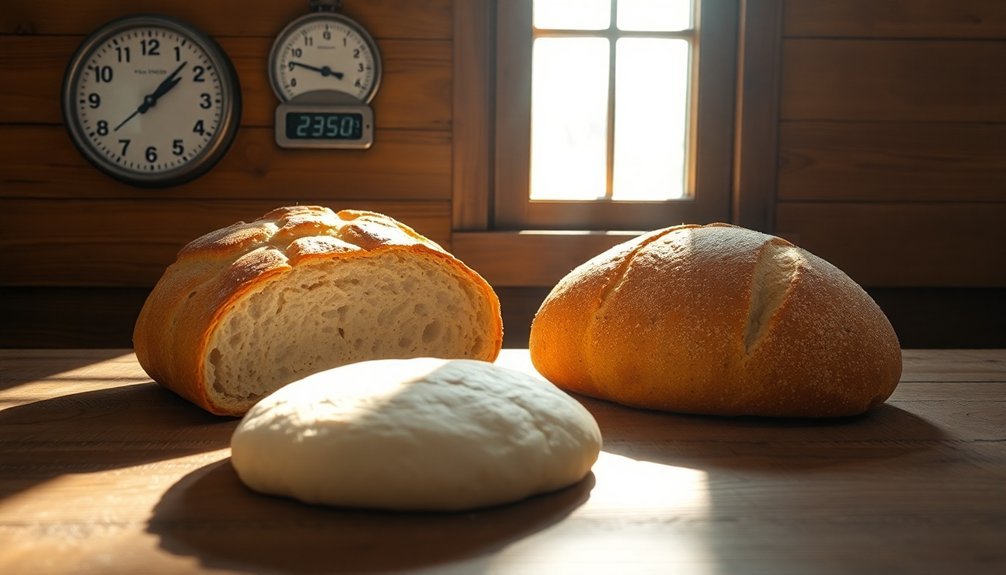
When you're converting traditional oven times to solar cooking times, you'll first need to understand how solar time works. Solar time is based on the Sun's position in the sky and differs from your standard clock time.
You'll encounter two types: apparent solar time, which tracks the actual Sun, and mean solar time, which uses an imaginary average Sun.
To convert your local time to solar time, you'll need to apply a Time Correction Factor that accounts for your longitude and the equation of time. These adjustments can vary by up to 16 minutes throughout the year due to Earth's tilted axis and elliptical orbit. For precise calculations, remember that each degree of rotation equals 4 minutes of time correction.
Remember that solar noon occurs when the Sun reaches its highest point, and the Sun moves 15 degrees across the sky each hour.
Temperature Ranges For Solar Cooking
You'll find different solar cooking devices offer distinct temperature ranges, with parabolic cookers reaching up to 800°F while box-type ovens and panel cookers typically operate between 160-400°F.
For most cooking tasks, you'll want temperatures between 200-300°F, which all properly designed solar cookers can achieve with good sunlight.
Your success in reaching ideal cooking temperatures depends greatly on using the right device for your needs and maintaining proper insulation, reflector positioning, and sun tracking throughout the cooking process. To maximize heating efficiency, using smooth reflective surfaces helps concentrate solar energy directly towards your food.
Heat Levels By Device
Different solar cooking devices offer distinct temperature ranges that determine their ideal cooking applications.
You'll find that parabolic cookers reach the highest temperatures, hitting up to 800°F, making them perfect for high-heat cooking methods like frying.
Box cookers operate between 160°F and 400°F, while panel cookers work best in the 200°F to 300°F range. Quality Sun Ovens can achieve 300°F to 400°F consistently with proper sunlight exposure.
- Parabolic cookers need precise sun alignment but deliver the most power for intense cooking tasks.
- Box cookers provide consistent heat for baking and slow cooking, requiring good insulation.
- Panel cookers work well for moderate-temperature dishes and are easier to manage.
For homemade designs, you can expect temperatures between 150°F and 400°F, depending on your construction quality and materials.
Success with any solar cooker depends on proper positioning and using dark cookware to maximize heat absorption.
Optimal Cooking Temperatures Range
Three key temperature ranges define successful solar cooking: 150°F to 400°F for well-made cookers, 180°F minimum for effective cooking, and 200°F to 300°F for most everyday dishes.
You'll find that higher temperatures between 300°F and 400°F work best for baking and grilling tasks, while lower temperatures from 180°F to 250°F are ideal for slow cooking to preserve nutrients and moisture in your food.
If you're planning to cook about 4 pounds of food, you'll need 1-2 hours for pasteurization or 3-4 hours for slow cooking.
Parabolic solar cookers can reach temperatures up to 550°F, making them comparable to traditional grills.
To maintain food safety, don't let your ingredients stay between 52°F and 125°F for more than four hours.
Using a thermometer will help you monitor internal temperatures and adjust your cooking times accordingly.
Adjusting Traditional Recipes
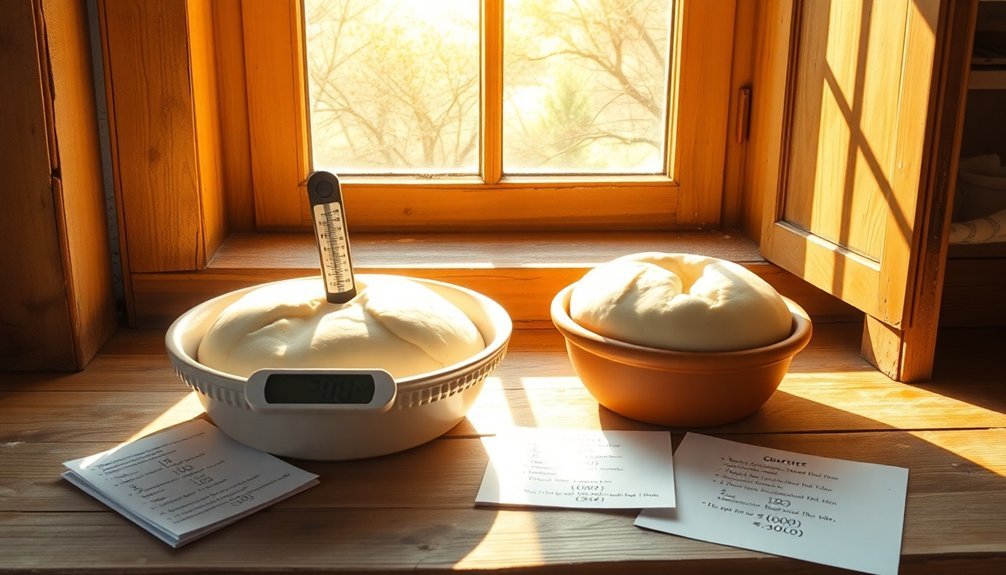
You'll need reliable temperature conversion charts to adapt your favorite recipes for solar cooking, as traditional oven temperatures don't directly translate to solar oven settings.
Your cooking times will typically run 1.5 to 2 times longer in a solar oven compared to conventional methods, depending on weather conditions and sunlight intensity.
When converting recipes, you'll want to monitor both the temperature gauge and cooking progress closely, as factors like cloud cover and wind can greatly impact your cooking ratios.
Temperature Conversion Charts Needed
Mastering temperature conversions between Fahrenheit and Celsius becomes essential when adapting traditional recipes for modern cooking methods.
You'll need to understand that converting from Fahrenheit to Celsius requires subtracting 32, multiplying by 5, and dividing by 9. For Celsius to Fahrenheit, multiply by 9, divide by 5, and add 32.
- Common oven temperatures like 350°F translate to 177°C (moderate heat for baking)
- Fan ovens require a 20°C reduction from conventional temperatures
- For precise baking, always use an external thermometer to verify accuracy
When adjusting recipes, remember that fan ovens cook faster due to air circulation.
While savory dishes can handle temperature variations, baking demands exact measurements.
Keep a conversion chart handy, and you'll confidently adapt any recipe.
Slower Cooking Time Ratios
Building on our temperature knowledge, adjusting cooking times for solar ovens requires careful calculations and patience. You'll need to account for slower cooking ratios when converting your favorite recipes.
| Food Type | Conventional Time | Solar Time |
|---|---|---|
| Bread | 30 min at 400°F | 40 min at 350°F |
| Beans | 1 hr at 375°F | 2 hrs at 300°F |
| Turkey | 3 hrs at 375°F | 5 hrs at 325°F |
You'll achieve the best results by spacing your food properly and using smaller containers. Remember to realign your solar oven every 30 minutes to maintain ideal temperature. On cloudy or windy days, you'll need to extend cooking times further. For consistent results, don't forget to preheat your solar oven and use a leveling rack for even heat distribution.
Seasonal Solar Cooking Times
When planning your solar cooking schedule, understanding seasonal variations is vital for success. You'll find the most effective cooking window between 11:00 am and 3:00 pm, when the sun's overhead position provides maximum UV rays.
In summer months, you can enjoy extended cooking periods, while winter requires more frequent adjustments and shorter cooking windows from 10:00 am to 4:00 pm.
- Summer offers ideal conditions with intense sunlight and longer cooking hours
- Spring and fall require adaptive strategies due to shortened daylight periods
- Winter cooking needs careful timing and more frequent solar oven adjustments
Your geographic location plays an important role too. If you're closer to the Equator, you'll benefit from consistent sunlight year-round, while northern regions may need to adapt their cooking schedules during winter months.
Weather Impact On Cooking
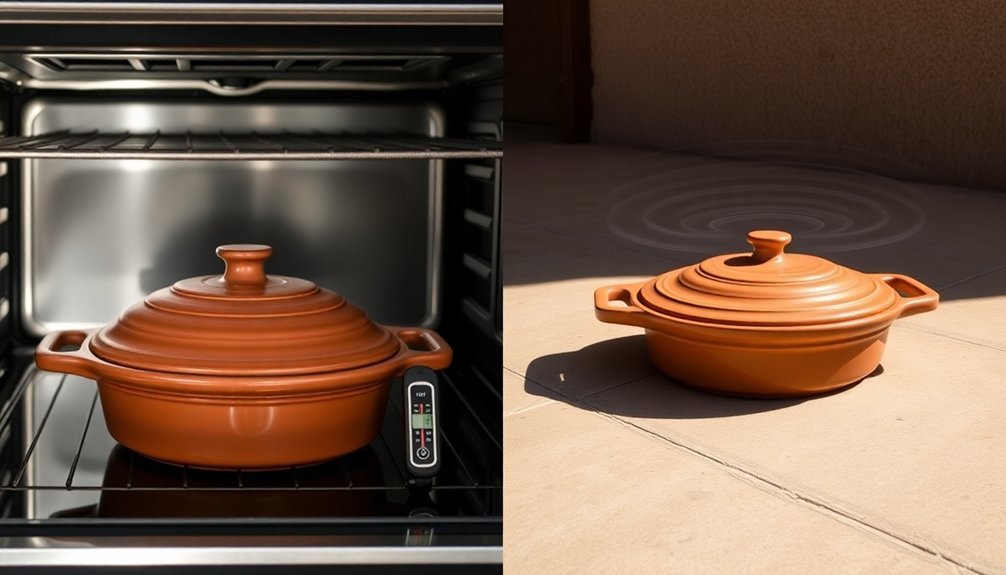
When cooking with solar energy, you'll find that cloud cover dramatically affects your cooking times by blocking direct sunlight and reducing heat intensity.
You'll need to account for humidity levels, which can slow down heat transfer and extend cooking durations, similar to how it affects traditional baking.
If you're planning to solar cook on an overcast or humid day, you'll want to start earlier and expect considerably longer cooking times compared to clear, dry conditions.
Cloud Cover Effects Timing
Cloud cover directly affects your outdoor cooking times by altering the temperature and heat distribution of your cooking surface.
When clouds block the sun, you'll need to adjust your cooking schedule since temperatures can drop considerably during the day.
During cloudy conditions, heat retention becomes more challenging, potentially requiring longer cooking times than you'd expect on clear days.
- Daytime cloud cover reflects sunlight away from your cooking area, requiring you to extend cooking times by 15-20%
- Nighttime clouds trap heat better, making evening grilling more predictable with stable temperatures
- You'll want to monitor your cooking surface temperature more frequently during variable cloud conditions
Understanding these timing adjustments helps you maintain consistent results, whether you're grilling, smoking, or using other outdoor cooking methods.
Remember that cloud forecasts can be your ally in planning successful outdoor meals.
Humidity Slows Heat Transfer
High humidity notably slows down heat transfer during outdoor cooking, making your cook times longer than expected.
When you're cooking in humid conditions, you'll notice that convection heating becomes less efficient since moist air transfers heat more slowly than dry air. This affects both natural convection and fan-forced methods.
While humidity won't impact conduction through direct contact (like when you're using a grill grate), it notably affects how heat moves through the air to your food.
You'll also face the challenge of latent heat – the energy required to evaporate moisture from your food's surface. In humid conditions, this evaporation process takes longer because the air is already saturated with moisture.
To compensate, you'll need to extend your cooking times and possibly adjust your temperature settings.
Solar Versus Conventional Baking
Since baking with solar power differs considerably from conventional methods, you'll need to adjust your expectations about cooking times and temperatures.
What takes 16 minutes in your electric oven at 375°F will require about 2 hours in a solar oven operating at 250-300°F. You'll notice that solar-baked goods retain more moisture but may not brown as easily on top.
- Your electric oven offers precise temperature control and consistent rise heights for reliable results.
- Solar baking preserves nutrients through slow, even heating but requires outdoor space and sunny weather.
- Black pots and reflective surfaces help maximize solar efficiency, though you'll need to adjust the oven's position throughout the day.
These differences mean you can't simply convert conventional recipes directly – you'll need to adapt your techniques and timing accordingly.
Altitude Effects On Timing

When cooking at elevated altitudes, you'll need to make significant adjustments to your baking times and temperatures.
For solar cooking at high altitudes, you'll need to increase your oven temperature by 15-25°F, except when using glass pans. However, you should reduce your baking time by 5-8 minutes for every 30 minutes of standard baking time.
You'll also need to account for moisture loss, as liquids evaporate more quickly at higher elevations. Add an extra egg or 3-4 tablespoons of water per cup of flour to maintain proper moisture.
Don't forget to decrease your leavening agents by 1/8 to 1/4 teaspoon per teaspoon in the recipe, as baked goods rise faster at altitude and can collapse if not properly adjusted.
Dish Size Considerations
Just as altitude affects your cooking adjustments, the size of your cookware plays a key role in solar cooking success.
You'll need to take into account how your dish size impacts heat distribution and cooking times when shifting from conventional to solar cooking. Larger pans will heat more evenly but take longer to reach ideal temperature, while smaller ones heat quickly but may develop hot spots.
- Choose cookware that matches your portion size – overcrowding or using too large a pan can lead to uneven cooking.
- Think about using multiple smaller dishes instead of one large container for more consistent results.
- Maintain consistent food depth across your cookware to guarantee even heating throughout.
When scaling recipes for solar cooking, you'll need to adjust both cooking times and temperatures based on your cookware selection, testing carefully to achieve the best results.
Best Times For Cooking
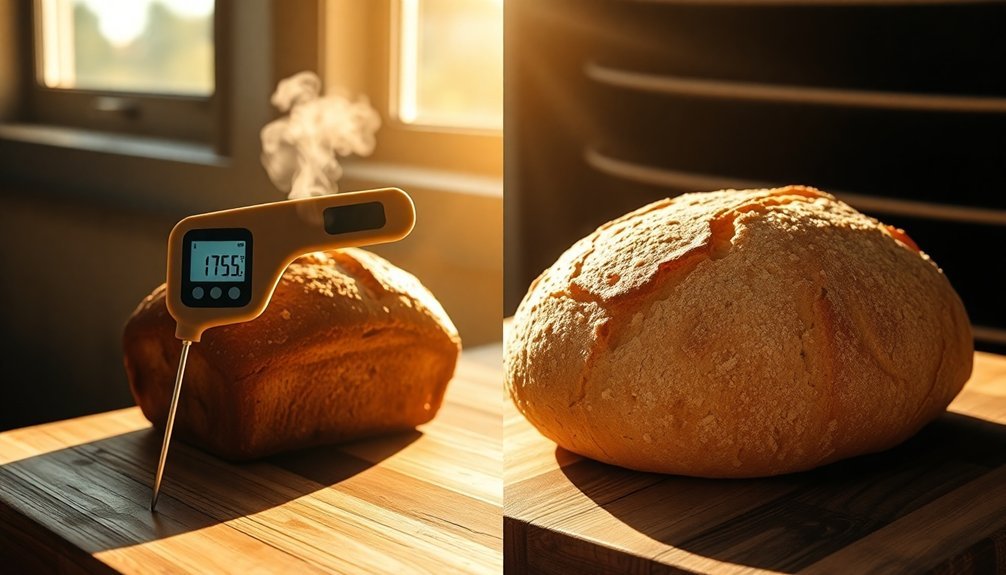
To maximize your solar cooking success, you'll want to plan your meals around peak sunlight hours between 10 AM and 4 PM. You'll achieve the best results during the most intense sun period from 11 AM to 3 PM, though you can cook all day by adjusting your oven's position to track the sun.
| Time of Day | Sun Intensity | Cooking Tips |
|---|---|---|
| 10-11 AM | Moderate | Preheat oven, start browning |
| 11 AM-1 PM | High | Main cooking period |
| 1-3 PM | High | Continue cooking |
| 3-4 PM | Moderate | Maintain warmth |
Remember that seasonal changes affect cooking times. In winter, you'll need more frequent oven adjustments, while summer offers longer unattended cooking periods. If you're cooking on partly sunny days, expect longer cooking times than with conventional ovens.
Preheating Your Solar Oven
Proper preheating stands as one of the most critical steps in solar cooking success. You'll need to position your solar oven in direct sunlight and let it heat up for 20-30 minutes before cooking. On clear days, you can expect temperatures around 300°F in just 20 minutes, with potential to reach 400°F in ideal conditions.
- Realign your oven every 30 minutes to maintain consistent temperatures
- Keep the glass door closed and latched during preheating to trap heat
- Use Dutch ovens or cast-iron pots to help retain heat longer
Even on cloudy days, you can achieve temperatures between 300-375°F with proper preheating.
Remember that opening the door will cause temperature drops, but the heat will recover gradually when closed. For best results, preheat while you're preparing your ingredients.
Monitoring Food Progress
Monitoring your solar oven's temperature fluctuations remains essential for achieving consistent cooking results.
You'll need to track real-time changes using buffered probe sensors and thermocouples positioned at different points in your cooking chamber.
Keep an eye on heat distribution patterns through your solar oven's monitoring system. You can use modern apps that provide robust tracking features while collecting data about temperature changes and solar conditions.
These tools will help you adjust the oven's position and reflectors based on the sun's movement throughout the day.
Don't forget to account for environmental factors like wind and cloud cover. Regular checks with calibrated sensors will guarantee accurate readings.
Use data loggers to record heat retention rates and temperature gradients, helping you identify hot spots and optimize cooking performance.
Quick Versus Slow Cooking Methods
Understanding how cooking times translate between traditional and solar methods helps you make informed decisions about meal preparation.
You'll find that quick cooking methods like high-pressure cooking can prepare meals up to 8 times faster than slow methods, while retaining more nutrients. In contrast, slow cooking techniques develop deeper flavors and achieve better tenderness, particularly for tough cuts of meat.
- Quick methods work best for thin cuts, vegetables, and foods that don't require tenderizing, making them ideal for last-minute meal preparation.
- Slow cooking excels at breaking down collagen and developing complex flavors, perfect for tough meats and stews.
- Solar cooking can accommodate both quick and slow methods, but you'll need to adjust your timing based on sun intensity and food type.
Frequently Asked Questions
How Do Reflector Angles Affect Cooking Time in Different Solar Oven Designs?
You'll cook faster with reflectors angled between 20-22.5 degrees from perpendicular to the glass. Your cooking time drops considerably when you adjust reflectors hourly to track the sun's movement.
Can Multiple Dishes Be Cooked Simultaneously Without Affecting Individual Cooking Times?
You'll need to add 15% extra time when cooking multiple dishes together. Use convection settings if available, maintain proper spacing, and monitor temperatures carefully to guarantee each dish cooks thoroughly without interference.
Does Food Spoilage Risk Increase With Longer Solar Cooking Times?
Yes, your food spoilage risk increases during longer solar cooking times. If temperatures stay in the danger zone (50-125°F) for over 3-4 hours, you'll need to discard the food to prevent food poisoning.
How Do Different Food Colors Affect Solar Cooking Absorption Rates?
You'll find that darker-colored foods absorb solar heat faster than lighter ones. When you're solar cooking, dark meats and vegetables will cook quicker, while pale foods like rice need more time or darker containers.
What Emergency Backup Timing Methods Exist When Solar Cooking Conditions Suddenly Change?
When solar cooking conditions deteriorate, you'll need to add an hour to standard cooking times if switching to backup methods like gas or propane stoves. Keep monitoring weather and have alternative fuel sources ready.
In Summary
You'll find that solar cooking times typically run 1.5-2 times longer than conventional oven cooking. When converting your recipes, start checking food at about double the original time. Remember that your solar cooking success depends heavily on weather conditions and sun position. For best results, you're better off cooking between 10 AM and 2 PM when the sun's at its strongest. Keep monitoring until you've reached desired doneness.

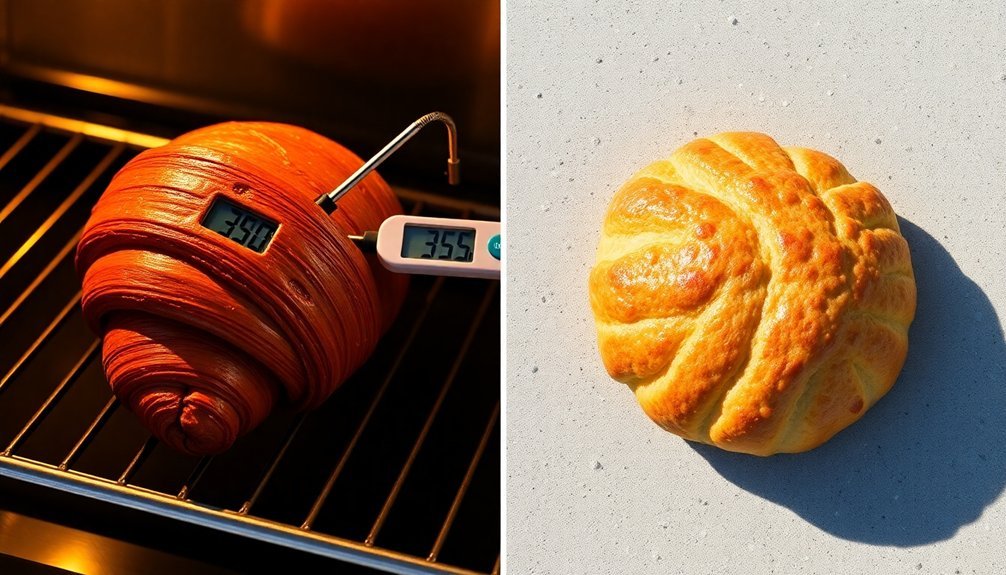



Leave a Reply